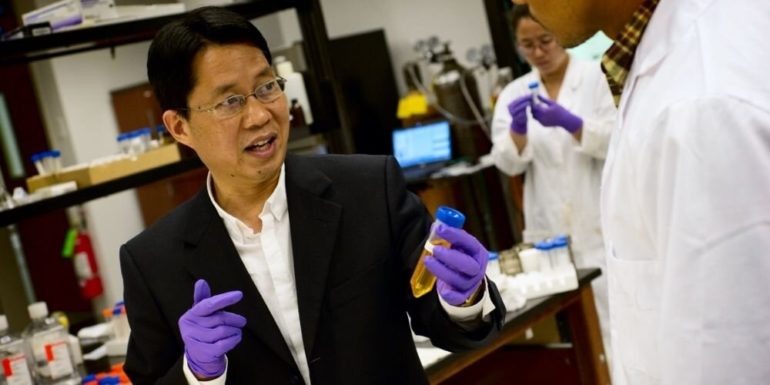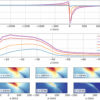An international team led by physics researchers at The University of Texas at Arlington has published a paper in Bioactive Materials that describes a breakthrough method of photodynamic therapy (PDT), an emerging cancer treatment.
Nil Kanatha Pandey, a doctoral student in physics Professor Wei Chen’s lab, is the first author of “Aggregation-induced emission luminogens for highly effective microwave dynamic therapy.” The study was led by Chen in collaboration with Lingyun Wang, a professor of chemistry and chemical engineering at South China University of Technology.
PDT combines photosensitive molecules, or photosensitizers, with light at the site of a tumor to produce a powerful oxygen species that destroys cancer cells. Researchers view PDT as a promising cancer treatment due to its minimal invasiveness and side effects, but the procedure is not without obstacles.
“In human tissue, the depth that light particles can reach is limited,” Chen said. “For cancers located deep within an organ or muscle, PDT is less effective because we can’t deliver light to the site of the tumor.”
Conventional photosensitive molecules used in PDT are also dependent on oxygen, which is often absent near the site of tumors. But an alternate method of tumor destruction known as thermal ablation offers a pathway to overcome the challenges of traditional PDT.
Thermal ablation is considered one of the most effective treatments in combined cancer therapy because it leads to improved tumor sensitivity to PDT, chemotherapy, immunotherapy or radiotherapy. During thermal ablation, the tissues are heated with microwave technology, causing the blood vessels to dilate, which increases blood flow. This heat also boosts the oxygen contained within the blood itself, thereby enhancing the efficacy of the treatment.
In its study, the team employed microwave technology to activate a special type of photosensitive molecule known as aggregation-induced emission luminophores (AIEgens). AIEgens are a new material that offer enhanced oxygen production over traditional photosensitizers. Chen and his researchers discovered that heating the cancer-affected area with microwave irradiation to activate AIEgens allowed for deep tissue penetration and generated a reactive oxygen species that killed the cancer cells.
The team asserts that the proposed method of microwave-induced PDT can be used either on its own or in combination with other cancer treatment methods such as surgery, chemotherapy, immunotherapy or radiotherapy.
“The microwave-induced PDT is a new phenomenon that has many advantages over traditional photodynamic therapy, such as maneuverability, faster ablation time and negligible side effects,” Chen said. “Most notably, it allows for deeper penetration of tissue.”
Chen’s team believes that its findings not only solve the issues of traditional PDT, but also help to improve conventional microwave ablation therapy by reducing the microwave dose needed to achieve the same outcomes, thereby decreasing the occurrence of side effects of microwave irradiation.
Chen said the combination of AIEgens and microwave technology could lead to the discovery of more effective methods of cancer treatment for hard-to-reach tumors.
“This finding will benefit investigations into photodynamic therapy by researchers around the world and open a door to new applications of AIEgens,” Chen said. “Our primary goal is to make PDT as effective and accessible for cancer patients as possible.”
Highly efficient photodynamic-immunotherapy by combining AIEgen with Poly(I:C)
More information:
Nil Kanatha Pandey et al, Aggregation-induced emission luminogens for highly effective microwave dynamic therapy, Bioactive Materials (2021). DOI: 10.1016/j.bioactmat.2021.05.031
Provided by
University of Texas at Arlington
Citation:
A breakthrough in photodynamic therapy (2021, July 15)
retrieved 15 July 2021
from https://medicalxpress.com/news/2021-07-breakthrough-photodynamic-therapy.html
This document is subject to copyright. Apart from any fair dealing for the purpose of private study or research, no
part may be reproduced without the written permission. The content is provided for information purposes only.



